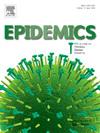Robust phylodynamic inference and model specification for HIV transmission dynamics
IF 2.4
3区 医学
Q2 INFECTIOUS DISEASES
引用次数: 0
Abstract
The robustness and statistical efficiency of phylodynamic models have been tested by many investigators. However, little attention has been given to model specification and inductive bias that can occur if the model is misspecified or provides an overly simplistic representation of the evolutionary process. Here, we carried out a study involving the simulation of HIV epidemics using a complex model and calibrated to men who have sex with men from San Diego, USA. We then used this epidemic trajectory to simulate genealogies, sequence alignments equivalent to HIV partial pol gene and the complete genome. We proceeded to estimate migration rates using a simplistic representation of the epidemiological model by testing model-based phylodynamics and phylogeographic methods. We observed that even though there were some biases on the estimates using a simplistic representation of the epidemiological model, we were still able to estimate the migration rates depending on the method and sample size used in the analyses.
HIV传播动力学的鲁棒系统动力学推断和模型规范
系统动力学模型的稳健性和统计效率已经被许多研究者检验过。然而,很少有人关注模型规范和归纳偏差,如果模型被错误地指定或提供了一个过于简单的进化过程的表示,则可能发生归纳偏差。在这里,我们进行了一项研究,使用一个复杂的模型来模拟艾滋病毒的流行,并校准了来自美国圣地亚哥的男男性行为者。然后,我们使用这种流行轨迹来模拟家谱,序列比对相当于HIV部分pol基因和完整基因组。我们通过测试基于模型的系统动力学和系统地理学方法,使用流行病学模型的简化表示来估计迁移率。我们观察到,尽管使用流行病学模型的简单表示估计存在一些偏差,但我们仍然能够根据分析中使用的方法和样本量估计迁移率。
本文章由计算机程序翻译,如有差异,请以英文原文为准。
求助全文
约1分钟内获得全文
求助全文
来源期刊

Epidemics
INFECTIOUS DISEASES-
CiteScore
6.00
自引率
7.90%
发文量
92
审稿时长
140 days
期刊介绍:
Epidemics publishes papers on infectious disease dynamics in the broadest sense. Its scope covers both within-host dynamics of infectious agents and dynamics at the population level, particularly the interaction between the two. Areas of emphasis include: spread, transmission, persistence, implications and population dynamics of infectious diseases; population and public health as well as policy aspects of control and prevention; dynamics at the individual level; interaction with the environment, ecology and evolution of infectious diseases, as well as population genetics of infectious agents.
 求助内容:
求助内容: 应助结果提醒方式:
应助结果提醒方式:


